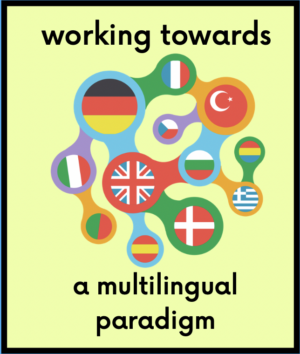Located at linguistically diverse Queens, LaGuardia Community College boasts an equally linguistically diverse student body as the above word clouds show (Nagano, Tables 1 & 2). According to the college’s Institutional Profile, 56% of students are non-native born; they come from 158 countries and speak 89 languages (Office of Institutional Research & Assessment).
What is the role of students’ heritage language⸺defined as “any language other than English that is spoken by an individual, a family, or a community”⸺in their education (Heritage Languages)? This depends on the kind of pedagogical approaches adopted by the teacher or the program. In New York City public schools (from which some of our students graduated), there are roughly three kinds of programs for students who do not speak English as their first language, and the roles of students’ heritage languages are different among these programs.
1) English as a Second Language (ESL) programs: To develop students’ literacy and social skills and master different content areas, teachers use a variety of strategies including culturally and personally relevant contexts, staging, visual aids, and role play. However, the medium of instruction is English only, and students’ heritage language plays little or no role in the classroom (New York State).
2) Transitional Bilingual Education (TBE) programs: Teachers integrate heritage language support and English to help students develop literacy and social skills and master different content areas. How much heritage language support is used depends on students’ English proficiency. The aim is to decrease the level of heritage language support as students’ English becomes more proficient (New York State).
3) Dual Language (DL) programs: Similar to their TBE counterparts, DL teachers integrate heritage language and English to help students develop literacy and social skills and master different content areas. However, DL programs have a different goal: it is to promote bilingualism and biliteracy. For example, teachers may teach a lesson in English and then deliver a similar or the same lesson in the heritage language (New York State).
What role do we want students’ heritage languages to play in our ENA classroom? We know that many of our students speak dialects or languages other than English or standard English in their daily lives. We are all too aware of non-native syntactic patterns in student writing. Yet, most of us are not trained in ESL, TBE, DL or other related education, and cannot do much about students’ multilingual backgrounds beyond sending them to the Writing Center “to fix the errors” or “to get help.” Little do we know that despite our good intentions, marking out language errors or strange wording “to fix” may send negative signals about a student’s heritage language: “It has no place here,” “You have language barriers to overcome,” “You don’t have native fluency.” Do we merely see multilingualism as part of a student’s background but do little beyond that? Do we want to help students tap into their heritage as a resource to develop their writing skills?
At LaGuardia, the World’s Community College, we can do better than assuming the implicit negative attitude toward students’ multilingual heritages: “You have a pattern of ESL errors to correct,” or “You need to improve your overall fluency.” In 2018, our colleagues Lucy McNair, Joy Sanchez-Taylor, and Evelyn Burg proposed that we “move away from this deficit model” and work toward a multilingual paradigm:
Considering the wide range of languages and varieties of English spoken on campus as assets to be understood and valued, we believe it important to work from a multilingual paradigm in our approach to ENA101. This involves a shift in perspective and a willingness to engage in learning ourselves. Generally, lack of standard American English should not be equated with lack of academic or communicative skills. Building off scholarship in composition studies, language acquisition, and linguistics, we wish to move away from this deficit model and develop instructional practices that encourage students to use all their linguistic resources in the classroom and build upon prior communication skills. (LaGuardia Community College English Department Working Group)
Lucy, Joy, and Evelyn further suggest several ways to integrate multilingual activities in the writing process:
1) Invite students to speak, write, or translate from other languages or English dialects and sociolects as part of the exploration of a text or the scaffolding of formal assignments;
2) Frequent comprehension checks;
3) Creative writing exercises;
4) Multiple prompts/genres of assignments;
5) More time for completing in-class work can also be useful.
The following activities and suggestions were developed thanks to the important groundwork by Lucy, Joy, and Evelyn. Any mistakes here are mine.
Works Cited
Heritage Languages in America: Research: Frequently Asked Questions. https://www.cal.org/heritage/research/faqs.html#1.
LaGuardia Community College English Department Working Group. ENA:101 Supporting Our Basic Writers in New Ways. 2018.
Nagano, Tomonori. “How Many Languages Are Spoken at LaGuardia? There Is No Simple Answer.” Ad Astra: Undergraduate Research Newsletter of LaGuardia Community College, vol. 3, 2020, http://www.adastraletter.com/2020/3/llanguages/.
New York State Manhattan/Staten Island Regional Bilingual / ESL Technical Assistance Centers (BETAC) Q and A. http://www.hunter.cuny.edu/msibetac/questions.html.
Office of Institutional Research & Assessment. LAGUARDIA COMMUNITY COLLEGE Institutional Profile 2020. https://www.laguardia.edu/uploadedfiles/main_site/content/ir/docs/institutional-profile-2020.pdf.



Leave a Reply